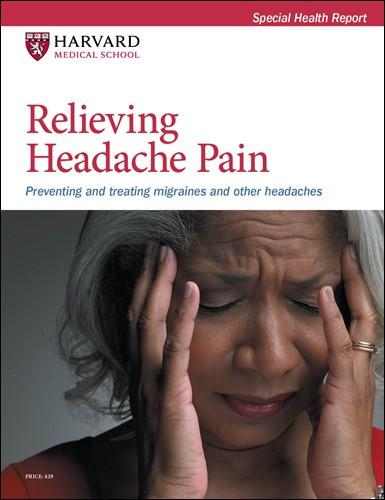
Zinc: What it does for the body, and the best food sources

Respiratory health harms often follow flooding: Taking these steps can help

Tips to leverage neuroplasticity to maintain cognitive fitness as you age

Can white noise really help you sleep better?

Celiac disease: Exploring four myths

What is prostatitis and how is it treated?

What is Cushing syndrome?

Exercises to relieve joint pain

Think your child has ADHD? What your pediatrician can do

Foam roller: Could you benefit from this massage tool?


Coping with Migraines
Migraine is a very common, often debilitating type of headache. The typical migraine headache is throbbing or pulsating, and often accompanied by nausea, vomiting, or loss of appetite. To make matters worse, migraines can leave you feeling exhausted for a day or more after the headache has faded. The Coping with Migraines Online Guide provides an in-depth exploration of migraines and their causes, symptoms, and treatment options. The report offers in-depth information on medications used to treat migraine pain, as well as newer drugs that can help prevent migraine headaches. And you’ll learn about nonmedication strategies such as trigger avoidance, and alternative therapies that have been shown to reduce the frequency and severity of migraines.
Other Product Information
Overview of Migraines
-
Migraines are a neurological condition with severe headaches.
-
Symptoms include nausea, sensitivity to light/sound, and visual disturbances.
-
Different types include migraines with aura, without aura, chronic, and hemiplegic migraines.
-
Common triggers: stress, hormonal changes, diet, environmental factors.
Treatment Options
-
Medications:
-
Acute treatments (pain relievers, triptans, CGRP inhibitors).
-
Preventive treatments for frequent migraines.
-
-
Non-medication strategies:
-
Lifestyle changes, diet adjustments, stress management.
-
Alternative therapies (acupuncture, mindfulness, biofeedback).
-
-
Importance of early intervention and personalized treatment.
Impact & Management
-
Migraines can affect work, social life, and mental health.
-
Coping strategies: support groups, counseling, and self-care techniques.
-
Research and advancements continue to improve migraine treatments.
Prepared by the editors of Harvard Health Publishing in consultation Paul Rizzoli, MD Associate Professor, Harvard Medical School Clinical Director, John R. Graham Headache Center, Brigham and Women’s Faulkner Hospital. 23 Pages. (2024)
About Harvard Medical School Guides
Harvard Medical School Guides delivers compact, practical information on important health concerns. These publications are smaller in scope than our Special Health Reports, but they are written in the same clear, easy-to-understand language, and they provide the authoritative health advice you expect from Harvard Health Publishing.
Green light therapy for migraines?
Sensitivity to light is a common feature of migraine headaches, which is one reason sufferers often seek out dark rooms during attacks. But is there any way of using light to ease your migraine pain and ward off headaches? There might be, if it’s the right kind of light.
Neuroscientist Rami Burstein at Harvard Medical School began examining the effect of different wavelengths on migraine pain after discovering that blue light worsened the pain in many sufferers who were blind. The light was apparently stimulating receptors in the retina, the light-sensing part of the eye. Although signals did not travel from there to the brain’s visual cortex, they did travel to the thalamus, the brain’s relay station for incoming sensory information.
Burstein wondered if blocking blue light could help alleviate migraines for a larger group of sufferers. In a study of 41 sighted people with migraines, he discovered that all bands of light except a narrow band of green light worsened migraine pain. More surprising, he found that this green light actually reduced pain in most participants by about 20%. While blue and red light energized the brain, green light calmed it down.
Later research from the University of Arizona confirmed that one to two hours of daily exposure to green light-emitting diodes (LEDs) for 10 weeks reduced average migraine days per month from 7.9 to 2.4 in a small group of people with episodic migraines (fewer than 15 in a month) and from 22.3 to 9.4 among a small group with chronic migraines (15 or more in a month). No adverse side effects were reported.
To date, the studies have been small, and the therapy is still considered experimental. But for people who don’t want to take medication, green light treatment might represent a viable option. The therapy appears to be most effective at night, when you can sit in a darkened room and avoid other wavelengths (in other words, don’t look at your phone, laptop, or TV). Use a lamp or LED strip that provides green light at a wavelength of 520 to 540 nanometers, and position it three to six feet away from you. (Dr. Burstein developed one such device called the Allay Lamp.) Use it one to two hours per day. It can take several weeks to deliver a benefit.
- What are migraines?
- What causes migraines?
- Preventing migraine headaches
- Treating migraine pain
- Resources
You might also be interested in…

Relieving Headache Pain: Preventing and treating migraines and other headaches

Zinc: What it does for the body, and the best food sources

Respiratory health harms often follow flooding: Taking these steps can help

Tips to leverage neuroplasticity to maintain cognitive fitness as you age

Can white noise really help you sleep better?

Celiac disease: Exploring four myths

What is prostatitis and how is it treated?

What is Cushing syndrome?

Exercises to relieve joint pain

Think your child has ADHD? What your pediatrician can do

Foam roller: Could you benefit from this massage tool?
Free Healthbeat Signup
Get the latest in health news delivered to your inbox!
Sign Up

